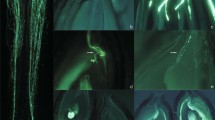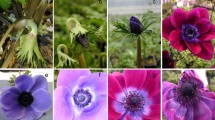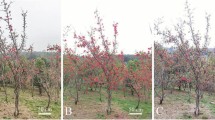Summary
Low yield in seed crops of perennial ryegrass is related to low fertilization efficiency and low temperature during anthesis. To study the effect of genotype and temperature on pollen performance, we conducted greenhouse experiments at controlled temperatures. Individual florets of four genotypes that are known to differ in seed production were hand pollinated at four temperatures (14°, 18°, 22°, 26° C) both in vivo and via a semiin-vitro method involving excised florets on agar. Pollen germination and tube growth were determined with UV-fluorescence microscopy and scored in six classes at 2 h after pollination in vitro and after 0.5, 2 and 5 h in vivo. In vitro, both genotype and temperature had a significant effect on the performance of self-pollen. Pollen tube growth increased with temperature. In cross-pollinations, the pistil parent had a significant effect on pollen tube growth, and there was also a significant pistil-by-temperature interaction. In vivo, genotype and temperature significantly affected pollen performance. The genotype-by-temperature interaction was only significant 5 h after pollination. One genotype with low seed yield was pseudoself-compatible and was a relatively poor mother after cross-pollination. The effects of genotype and temperature on the growth of self-pollen might be exploited in a breeding programme.
Similar content being viewed by others
References
Beddows AR, Breese EL, Lewis B (1962) The genetic assessment of heterozygous breeding materials by means of a diallei cross. Heredity 17:501–512
Burbidge A, Hebblethwaite PD, Ivins JD (1978) Lodging studies in Lolium perenne grown for seed. 2. Floret site utilization. J Agric Sci 90:269–274
Cornish MA, Hayward MD, Lawrence MJ (1979) Self-incompatibility in ryegrass. I. Genetic control in diploid Lolium perenne L. Heredity 43:95–106
Cornish MA, Hayward MD, Lawrence MJ (1980) Self-incompatibility in ryegrass. IV. Seed set in diploid Lolium perenne L. Heredity 44:333–340
Elgersma A (1985) Floret site utilization in grasses: definitions, breeding perspectives and methodology. J Appl Seed Prod 3:50–54
Fearon CH, Hayward MD, Lawrence MJ (1983) Self-incompatibility in ryegrass. VI. Self seed-set and incompatibility genotype in Lolium perenne L. Heredity 50:169–177
Foster CA, Wright CE (1970) Variation in the expression of self-fertility in Lolium perenne. Euphytica 19:61–70
Gawel NJ, Robacker CD (1986) Effect of pollen-style interaction on the pollen tube growth of Gossypium hirsutum. Theor Appl Genet 72:84–87
Griffiths DJ (1965) Breeding for higher seed yields from herbage varieties. J Nat Inst Agric Bot 10:320–331
Jenkins TJ (1931) Self-fertility in perennial ryegrass (Lolium perenne L.) Bull. Welsh Plant Breed Stn Ser H 12:100–119
Hampton JG, Hebblethwaite PD (1983) The effects of the environment at anthesis on the seed yield and yield components of perennial ryegrass (Lolium perenne L.) cv. S 24. J Appl Seed Prod 1:21–22
Lawrence MJ, Fearon MA, Cornish MA, Hayward MD (1983) The genetical control of self-incompatibility in ryegrasses. Heredity 51:461–466
Leach CR (1984) Are there more than two self-incompatibility loci in the grasses? Heredity 52:303–305
Lundqvist A (1961) A rapid method for the analysis of incompatibility in grasses. Hereditas 52:705–707
Mazer SJ (1987) Parental effects on seed development and seed yield in Raphanus raphanistrum: implications for natural and sexual selection. Evolution 41:355–371
McGraw JM, Spoor W (1983) Self-incompatibility in Lolium species. II. Lolium perenne L. Heredity 50:29–33
Pfahler PL (1970) In vitro germination and pollen tube growth of maize (Zea mays) pollen. III. The effect of pollen genotype and pollen source vigor. Can J Bot 48:111–115
Sacher RF, Mulcahy DL, Staples RC (1983) Developmental selection during self-pollination of Lycopersicon x Solanum F1 for salt tolerance of F2. In: Mulcahy DL, Ottaviano E (eds) Pollen: biology and implications for plant breeding. Elsevier, Amsterdam New York, pp 329–334
Sari-Gorla M, Ottaviano E, Faini D (1976) Genetic variability of gametophytic growth rate in maize. Theor Appl Genet 46:289–294
Spoor W (1976) Self-incompatibility in Lolium perenne L. Heredity 37:417–421
Tanksley SD, Zamir D, Rick CM (1981) Evidence for extensive overlap of sporophytic and gametophytic gene expression in tomato. Science 213:453–455
Willing RP, Mascarenhas JP (1984) Analysis of the complexity and diversity of mRNAs from pollen and shoots of Tradescantia. Plant Physiol 75:865–868
Zamir D, Tanksley SD, Jones RA (1981) Low-temperature effect on selective fertilization by pollen mixtures of wild and cultivated tomato species. Theor Appl Genet 59:235–238
Author information
Authors and Affiliations
Additional information
A.G. Stephenson was on a sabbattical leave at SVP in 1987
Rights and permissions
About this article
Cite this article
Elgersma, A., Stephenson, A.G. & den Nijs, A.P.M. Effects of genotype and temperature on pollen tube growth in perennial ryegrass (Lolium perenne L.). Sexual Plant Reprod 2, 225–230 (1989). https://doi.org/10.1007/BF00195583
Issue Date:
DOI: https://doi.org/10.1007/BF00195583




